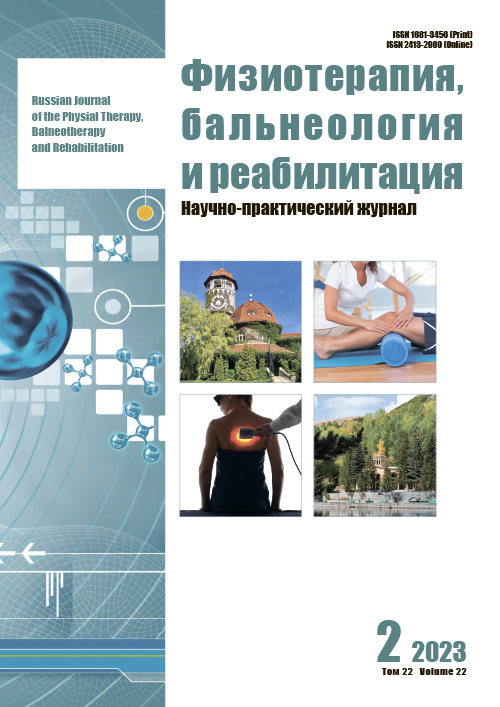The use of the SIMONA 111 integrated monitoring system in assessing the dynamics of rehabilitation treatment of patients with past coronavirus pneumonia. Clinical observations
- Authors: Kostenko A.A.1,2, Koneva E.S.1,2, Maliutin D.S.1,2, Tsvetkova A.V.1,2, Bisheva D.R.1
-
Affiliations:
- The First Sechenov Moscow State Medical University (Sechenov University)
- MEDSI Group of Companies
- Issue: Vol 22, No 2 (2023)
- Pages: 129-135
- Section: Articles
- Published: 07.01.2024
- URL: https://rjpbr.com/1681-3456/article/view/119533
- DOI: https://doi.org/10.17816/119533
- ID: 119533
Cite item
Abstract
The new coronovirus infection affects not only physical health, but also causes significant damage to the mental state of the population. Therefore, the stage of rehabilitation treatment makes it necessary to combine various treatment methods for the most effective restoration of the quality of life and psychological comfort of patients.
This article presents clinical observations as part of a study of rehabilitation methods after a new coronavirus infection brought on the basis of Sechenov University and Medsi Clinical Hospital No. 1. A distinctive feature of rehabilitation was the use of hypoxic/hyperoxy therapy in combination with the main course of rehabilitation treatment and the SIMONA 111 integrated monitoring system as a method of control, treatment analysis and a way of visual interaction with patients. This approach allowed not only to obtain objective data on the dynamics of treatment, but also to establish better contact with the patient.
Full Text
About the authors
Aleksandra A. Kostenko
The First Sechenov Moscow State Medical University (Sechenov University); MEDSI Group of Companies
Author for correspondence.
Email: sanny.doc@gmail.com
ORCID iD: 0000-0002-9653-2313
SPIN-code: 2730-9531
Graduate Student
Russian Federation, Moscow; Otradnoye, Moscow RegionElizaveta S. Koneva
The First Sechenov Moscow State Medical University (Sechenov University); MEDSI Group of Companies
Email: koneva_e_s@staff.sechenov.ru
ORCID iD: 0000-0002-9859-194X
SPIN-code: 8200-2155
MD, Dr. Sci. (Med.), Professor
Russian Federation, Moscow; Otradnoye, Moscow RegionDanil S. Maliutin
The First Sechenov Moscow State Medical University (Sechenov University); MEDSI Group of Companies
Email: malyutin.danil@gmail.com
ORCID iD: 0000-0002-9196-9268
SPIN-code: 7730-3955
Russian Federation, Moscow; Otradnoye, Moscow Region
Alena V. Tsvetkova
The First Sechenov Moscow State Medical University (Sechenov University); MEDSI Group of Companies
Email: tv-aa@yandex.ru
ORCID iD: 0000-0002-2698-3514
Assistant Lecturer
Russian Federation, Moscow; Otradnoye, Moscow RegionDiana R. Bisheva
The First Sechenov Moscow State Medical University (Sechenov University)
Email: dianabisheva25@mail.ru
ORCID iD: 0000-0003-2220-0604
Russian Federation, Moscow
References
- Carda S, Invernizzi M, Bavikatte G, et al. COVID-19 pandemic. What should physical and rehabilitation medicine specialists do? A clinician’s perspective. Eur J Phys Rehabil Med. 2020;56(4):515–524. doi: 10.23736/S1973-9087.20.06317-0
- Chang MC, Park D. How should rehabilitative departments of hospitals prepare for coronavirus disease 2019? Am J Phys Med Rehabil. 2020;99(6):475–476. doi: 10.1097/PHM.0000000000001428
- Herridge MS, Tansey CM, Matté A, et al.; Canadian Critical Care Trials Group. Functional disability 5 years after acute respiratory distress syndrome. N Engl J Med. 2011;364(14):1293–304. doi: 10.1056/NEJMoa1011802
- Kim ES, Chin BS, Kang CK, et al.; Korea National Committee for Clinical Management of COVID-19. Clinical course and outcomes of patients with severe acute respiratory syndrome coronavirus 2 infection: A preliminary report of the first 28 patients from the Korean cohort study on COVID-19. J Korean Med Sci. 2020;35(13):e142. doi: 10.3346/jkms.2020.35.e142
- Razumov AN, Ponomarenko GN, Badtieva VA, et al. Medical rehabilitation of patients who have undergone COVID-19 in sanatorium organizations: Guidelines. Saint Petersburg; 2021. 30 p. (In Russ).
- Kotenko KV, Frolkov V, Nagornev SN, et al. Prospects for the use of drinking mineral waters in the rehabilitation of patients with coronavirus (COVID-19) infection: Analysis of the main sanogenetic mechanisms. Questions Balneology Physiotherapy Therapeutic Physical Culture. 2021;98(6-2):75–84. (In Russ). doi: 10.17116/kurort20219806275
- Tsyganova TN, Frolkov VK, Korchazhkina NB. Pathogenetic justification of the use of hypo-hyperoxic training in the treatment and prevention of complications of coronavirus infection COVID-19. Physiotherapist. 2021;(1):14–25. (In Russ). doi: 10.33920/med-14-2102-02
- Negrini S, Ferriero G, Kiekens C, Boldrini P. Facing in real time the challenges of the COVID-19 epidemic for rehabilitation. Eur J Phys Rehabil Med. 2020;56(3):313–315. doi: 10.23736/S1973-9087.20.06286-3
- Vindegaard N, Benros ME. COVID-19 pandemic and mental health consequences: Systematic review of the current evidence. Brain Behav Immun. 2020;(89):531–542. doi: 10.1016/j.bbi.2020.05.048
- Labrecque PF, Harvey J, Nadreau É, et al. Validation and cardiorespiratory response of the 1-min sit-to-stand test in interstitial lung disease. Med Sci Sports Exerc. 2020;52(12):2508–2514. doi: 10.1249/MSS.0000000000002423
- Salehi M, Amanat M, Mohammadi M, et al. The prevalence of post-traumatic stress disorder related symptoms in Coronavirus outbreaks: A systematic-review and meta-analysis. J Affect Discord. 2021;(282):527–538. doi: 10.1016/j.jad.2020.12.188
- Antonov AA, Tokarev AR. System hardware monitoring using a hardware-software complex under stress (brief communication). Bulletin New Med Technologies. 2021;(1):78–79. (In Russ). doi: 10.24412/1609-2163-2021-1-78-79
- Kuzmenko KS, Tokarev AR, Kireev SS. The use of serotonin adipinate and non-invasive monitoring of vital functions in a child with diffuse appendicular peritonitis (clinical case). Bulletin New Med Technologies. Electronic edition. 2022;16(4):7–12. (In Russ). doi: 10.24412/2075-4094-2022-4-1-1
- Leonov I, Grigorenko VV, Eskov VM, et al. Automation of the diagnosis of age-related changes in the parameters of the cardiovascular system // Med Tech. 2018;(3):48–51. (In Russ).
- Patent RUS № 2742161 C1, 02.02.2021. Application No. 2020116266 dated 04/24/2020. Tokarev AR, Antonov AA, Khadartsev AA. A method for diagnosing stress resistance. (In Russ). Available from: https://yandex.ru/patents/doc/RU2742161C1_20210202. Accessed: 15.01.2023.
- Tokarev AR, Khadartsev AA. Hardware-software method for detecting occupational stress and the possibility of its correction by transcranial electrical stimulation (brief communication). Bulletin New Med Tech. Electronic edition. 2017;(4):226–231. (In Russ). doi: 10.12737/article_5a38d3425cbed3.24947719
Supplementary files







